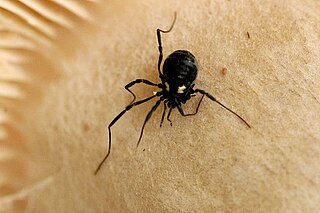
The Opiliones are an order of arachnids, colloquially known as harvestmen, harvesters, harvest spiders, or daddy longlegs. As of July 2024, over 6,650 species of harvestmen have been discovered worldwide, although the total number of extant species may exceed 10,000. The order Opiliones includes five suborders: Cyphophthalmi, Eupnoi, Dyspnoi, Laniatores, and Tetrophthalmi, which were named in 2014.

Dyspnoi is a suborder of harvestmen, currently comprising 43 extant genera and 356 extant species, although more species are expected to be described in the future. The eight families are currently grouped into three superfamilies: the Acropsopilionoidea, Ischyropsalidioidea, and Troguloidea.

Ogoveidae is a family of harvestmen with three described species in one genus, Ogovea, which is found in equatorial West Africa.

The Nemastomatidae are a family of harvestmen with about 170 described species in 16 recent genera. Several fossil species and genera are known.

Opiliones are an order of arachnids and share many common characteristics with other arachnids. However, several differences separate harvestmen from other arachnid orders such as spiders. The bodies of opiliones are divided into two tagmata : the abdomen (opisthosoma) and the cephalothorax (prosoma). Unlike spiders, the juncture between the abdomen and cephalothorax is often poorly defined. Harvestmen have chelicerae, pedipalps and four pairs of legs. Harvestmen were traditionally thought to have two eyes, except in the case of eyeless species. Developmental genetic work has shown that living species retain up to six eyes, including one pair of rudimentary median eyes and one pair of rudimentary lateral eyes.
Asiolasma ailaoshan is a species of harvestman belonging to the family Nemastomatidae. It is endemic to Yunnan Province, China. It was initially described in the genus Cladolasma before being redefined within Asiolasma when that genus was newly described.
Cladolasma, is a genus of harvestmen belonging to the family Nemastomatidae. The genus is monotypic containing a single species Cladolasma parvulum. They are endemic to Japan, with records in Ehime and Tokushima Prefectures. The genus was described by Seisho Suzuki, with the type species Cladolasma parvulum Suzuki, 1963, subsequently revised to Dendrolasma parvulum in Suzuki (1974), but later restored as a valid genus.
Asiolasma damingshan, is a species of harvestman belonging to the family Nemastomatidae. It is endemic to Guangxi Autonomous Region. China. It was initially described in the genus Cladolasma before being redefined within Asiolasma when that genus was newly described.

Ortholasma is a genus of harvestmen in the family Nemastomatidae with 5 described species. The genus has been revised by Shear (2010).

Dendrolasma is a genus of harvestmen in the family Nemastomatidae with two described species. Both species are found in the western coast of North America. An overview of their taxonomy was provided by Schönhofer (2013).

Ortholasmatinae is a subfamily of harvestmen in the family Nemastomatidae with 27 described species in 7 genera. They are found in temperate and often mountainous regions of the Northern Hemisphere.

Nemastomatinae is a subfamily of harvestmen with over 125 described species in 19 (extant) genera. They are usually found in temperate regions.
Asiolasma is a genus of harvestmen in the family Nemastomatidae with six described species . The species are found in Southeast Asia, namely China, Vietnam and Thailand. Some species are treated under other genera in Schönhofer (2013).
Asiolasma billsheari is a species of harvestmen belonging to the family Nemastomatidae. It is found in China, Gansu Province. It was described in the genus Asiolasma.
Asiolasma schwendingeri is a species of harvestmen belonging to the family Nemastomatidae. It is found in Vietnam, Ha Noi Province. It was described in the genus Asiolasma.
Asiolasma juergengruberi is a species of harvestmen belonging to the family Nemastomatidae. It is endemic to northern Yunnan Province China. It was described in the genus Asiolasma.
Dendrolasma dentipalpe is a species of harvestman in the family Nemastomatidae. It is found in North America, in USA California. The species was described by Shear & Gruber, 1983, who reported the holotype from the US in "Carlotta, Humboldt County", alongside other Californian specimens.
Martensolasma is a genus of harvestmen in the family Nemastomatidae with two described species . Both species are found in Mexico. The type species was include in catalog by Schönhofer (2013). The genus Martensolasma was described by William Shear, with the type species Martensolasma jocheni Shear, 2006. A second species was later added to the genus by Cruz-López, 2017.
Trilasma is a genus of harvestmen in the family Nemastomatidae with nine described species . The species are mainly found in Mexico.





